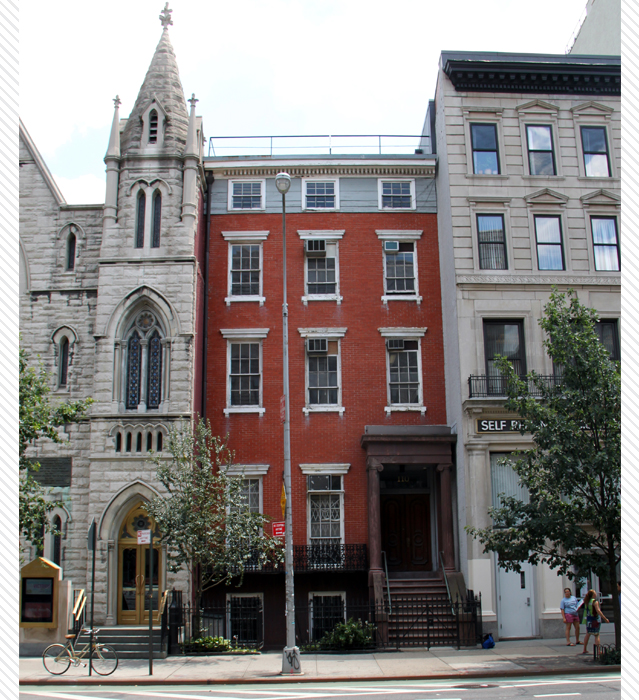Tragedy on Second Avenue
On December 5, 2020 at about 5:00am, a fire broke out at 116 Second Avenue, a neo-Grec tenement. The six-alarm blaze spread to the 1892 Middle Collegiate Church next door to the south. Nearly 200 firefighters were dispatched and while four suffered minor injuries, thankfully the human toll did not go beyond that.

However, the toll on our East Village buildings is significant. No. 116 Second Avenue has been razed. The church has suffered incredible damage and even the Isaac T. Hopper home at No. 110 Second Avenue experienced fire and water damage, although apparently no structural damage. All three are part of the East Village/Lower East Side Historic District and No. 110 is an individual New York City landmark. Today we thought we would look at these buildings and their respective histories.

110 Second Avenue
This three-story Greek Revival-style row house was erected in 1837-38. Between 1845 and 1857, it was the home of the prosperous South Street commission merchant Ralph Mead and his wife Ann Van Wyck. The Ralph and Ann E. Van Wyck Mead House is the only remaining row house of four houses that were constructed for Mead’s extended family. Later, in 1874, the building became the Issac T. Hopper Home of the Women’s Prison Association, a reform organization founded in 1845 by Issac Tatem Hopper (1771-1852) and his daughter Abigail Hopper Gibbons (1801-1893), who sought to better the lives of women who had been through the criminal justice system.
The Women’s Prison Association and Home was originally located in a rented house, known as the Hopper House, on Fourth Street (later moved to Tenth Avenue) in order to train and rehabilitate women either convicted of a crime or awaiting trial. The organization encouraged religion among the women and provided training in domestic skills, job placement and lodging all in an environment free from the supervision of men. In 1874 the organization purchased the home at 110 Second Avenue as a more suitable building for the organization’s mission. In 2009, Village Preservation gave the WPA a Village Award.
To this day, the house is still owned by the Women’s Prison Association. In 1992 the Hopper House was renovated and re-opened as a residential alternative to imprisonment for women. The building was designated as an individual New York City landmark in 2009.


112-114 Second Avenue
This Gothic Revival-style church was built in 1891-92 and designed by architect Samuel B. Reed for the Collegiate Reformed Protestant Dutch Church. It was constructed entirely from Indiana limestone and the facade is three bays wide, featuring a gabled three-story central bay, a 130-foot hexagonal limestone spire on the five-story tower of the northern bay, and another hexagonal limestone spire on the four-story southern bay. Other features include a peaked entry vestibule with a pointed-arched main entrance, pointed-arched window openings, and elaborate stained-glass windows which were possibly made by Tiffany & Co. The highest tower has a bell that was cast in Amsterdam and installed in the church’s previous Nassau Street location, where it rang when the Declaration of Independence was signed. It was dedicated on June 26, 1892 and The New York Times described its 130-foot spire as making it “one of the most as one of the most conspicuous objects in that section of the city.”
The church has served the community continuously since its dedication and has done so with virtual services since the pandemic. As stated on its webpage:
The diversity of our congregation and staff looks like a New York City subway but it feels like a home full of love. Middle Church is where therapy meets Broadway; where art and dance meet a gospel revival; where old time religion gets a new twist. We are Bach, Beatles, and Beethoven; we are jazz, hip-hop, and spirituals. We are inspired by Howard Thurman, Ruby Sales, Fannie Lou Hamer, and Martin Luther King. We are on-your-feet worship and take-it-to-the-streets activism. We feed the hungry and work for a living wage; we fight for LGBTQ equality and march for racial/ethnic justice. We stand up for the stranger and the immigrant; we care for women’s lives and Mother Earth.
And the church will continue to serve the community, in spite of the fire.


116 Second Avenue
Tax records indicate that the house at 116 Second Avenue (aka 48 East 7th Street) was constructed between 1845 and 1846 as a row house. The building was increased in height from three-and-a-half to five stories c. 1884 -1885, sometime after the construction of 48 ½ East 7th Street on the eastern portion of the tax lot (c. 1875-76). It featured neo-Grec ornament including the incised detail at its window lintels. The 1900 Federal census shows families of Irish and German descent, very much speaking to the immigrant history that is part and parcel of the East Village.

So while we mourn the loss of No. 116, we hope that the church will be able to be restored and are truly thankful that no one was seriously injured. For more information on the East Village/Lower East Side Historic District, click HERE.
